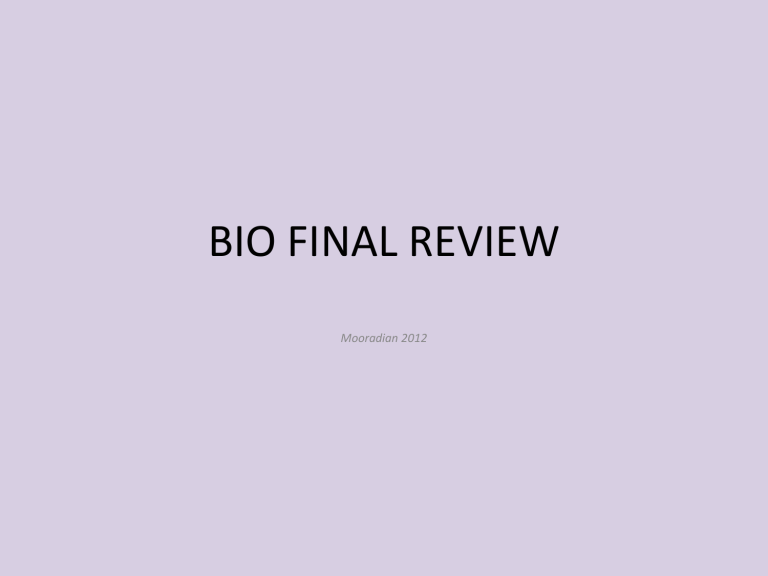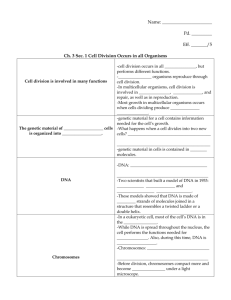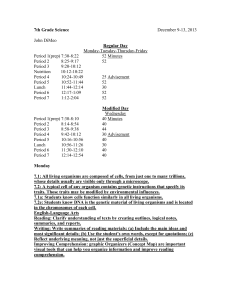cells

BIO FINAL REVIEW
Mooradian 2012
Eukaryotic Cells are Larger than
Prokaryotic cells
Organisms that are Eukaryotic:
Every organisms that is not bacteria
– Animals
– Plants
– Fungus
– Protists
Organisms that are Prokaryotic:
Every bacterial cell
– Eubacteria
– Archeabacteria
Eukaryotic vs. Prokaryotic Cells
Eukaryotic Cells
• Large
• Have chromosomes
• Have membranebound organelles
– Nucleus
– Mitochondria
– Centrioles
Prokaryotic Cells
• Small
• No chromosomes, only small circle of
DNA (plasmid)
• No membranebound organelles.
Animal
• No cell wall
• No chloroplast
• Small vacuoles
• Has centrioles
Plant
• Cell wall
• Chloroplasts
• Large vacuole
• No centrioles
Please review the following organelles:
• Cell wall
• Cell membrane
• Nucleus
• Mitochondria
• Chloroplast
• vacuole
Cell Wall
• A rigid structure found on the outside of plant, fungal and bacterial cells
• Permeable – allows most substances to enter freely
• Composed of cellulose and protein
• Located OUTSIDE of the cell membrane
• Structure relates to function:
– The rigid structure of the cell wall provides support and structure for the organisms
Cell Membrane
• Surrounds ALL cells
• Semi-permeable – only allows certain substances to pass through
• Contains proteins that help to pass materials through.
• “Phospholipid bilayer”
• Flexible and “fluid”
Nucleus
• Membrane-bound organelle
• Found only in Eukaryotes
• Controls the cell functions and processes
• Contains DNA that directs the formation of necessary proteins. (genetic blueprint)
MITOCHONDRIA
• “Powerhouse” of the cell
• Converts food into energy (ATP)
• Inner and outer membrane
• Has it’s own DNA (endosymbiotic theory)
• Found in Eukaryotes only
• Found in both plants and animals
CHLOROPLASTS
• Converts sunlight, water and carbon dioxide to sugar and oxygen through photosynthesis
– Has chlorophyll – pigment that captures the sun’s light.
• Inner and outer membrane
• Found in Eukaryotes only
• Found only in plants
(producers/autotrophs)
Biogeochemical Cycles
• Water Cycle (hydrological)
– How water is transferred from the atmosphere to earth, through organisms and back to the atmosphere
• Carbon Cycle
– How carbon dioxide and oxygen are cycled from the atmosphere through organisms and back to the atmosphere.
• Nitrogen Cycle
– How organisms convert (fix) unusable nitrogen in the atmosphere to usable nitrogen to make proteins
Carbon Cycle
TERMS
• Respiration
• Photosynthesis
• Combustion
• Decomposition
• Fossil Fuels
FOSSIL FUELS
• Fossil fuels are made from organisms that died millions of years ago and were buried
• They are “non-renewable”, meaning there is a limited supply.
• Examples:
– Coal, oil and gas
(fossil fuels)
-nuclear power*
*sometimes
Considered
Renewable, but we
WILL run out of uranium
Renewable Resources
• Resources that have unlimited supply.
• Often considered “ green ”
• Often do not release harmful pollutants and/or carbon dioxide
• Examples:
– Wind, solar, geothermal, hydroelectric (water)
Acid Rain
• Acid rain is formed when nitric and
sulfuric acid is released into the atmosphere from coal-burning power plants.
• An increase in the acidity of an ecosystem causes many organisms to die
• Ecosystems downwind from factories experience the most acid rain
Global Warming
• When fossil fuels are burned to make energy, they release CO
2 and other harmful substances into the atmosphere.
• High levels of CO
2 have been linked to increasing temperatures on Earth
(Greenhouse Effect)
• Increasing temperatures on Earth will lead to climate changes (Global Warming)
Destroying the Ozone Layer
• The ozone layer is a part of our atmosphere that protects us from carcinogenic (cancer causing) UV rays from the sun.
• Chloroflourocarbons (CFCs) – found in aerosol can products and coolants
• CFCs attack and destroy ozone
• Most countries have banned CFCs
PHOTOSYNTHESIS
AND
CELLULAR RESPIRATION
PHOTOSYNTHESIS
6CO
2
+ 6H
2
0 C
6
H
12
O
6
+ 6O
2 reactants products
Carbon dioxide + water glucose + oxygen
Cellular Respiration – releases the energy in food and turn it into a form that can be used for the activities of life
C
6
H
12
0
6
+ 60
2
6CO
2
+ 6H
2
O + 36 ATP
OR
Sugar (glucose) + oxygen carbon dioxide + water + energy
Identify products and reactants
*Reactants ALWAYS to the LEFT of the Arrow
Know what are the REACTANTS of
Photosynthesis
(Sunlight, Water,
Carbon Dioxide) and the PRODUCTS
(Oxygen and
Glucose), the
Simplified
REACTANTS of
Cellular Respiration
(Oxygen, Glucose) and the PRODUCTS
(Energy-ATP, Carbon
Dioxide and Water)
Genetics
• Organisms are a product of the genes they receive from their parents. These genes make proteins, such as pigments, that make individuals who they are/what they look like – to an extent…..
Structure of DNA
• DNA is made up of nucleotides. Each nucleotide of DNA consists of:
– A sugar “deoxyribose”
– A phosphate
– A nitrogenous base:
• Adenine Thymine
• Cytosine Guanine
‘A’ binds with ‘T’, ‘C’ binds with ‘G’
When nucleotides are bonded, they compose a DNA molecule
• Double-helix/spiral ladder
• Sugar-phosphate “backbone”
• Bases are rungs of ladder
• Long sequences of bases make up genes
Number of Chromosomes
• Organisms have 2 different types of cells
– Body (somatic) cells: skin, liver, brain
– Sex cells (gametes): sperm and egg
• Because sperm and egg need to meet and combine their chromosomes to form a new individual, they have ½ the number of chromosomes as body cells
CHROMOSOME NUMBERS
sex cells/haploid (N) Body cells/diploid (2n)
• 23
• 12
• 4
• 20
• 10
• 22
•
•
• 46
• 24
• 8
• 40
20
44
In Humans Sex cells have 23 (23 from Sperm + 23 from Egg = 46)
Cells are formed by Mitosis and Meiosis
• Mitosis is the division of a cell into body cells. (End with TWO daughter cells, EACH with diploid # of chromosomes- 46 in humans)
• Meiosis is the division of a cell into sex cells. (End with FOUR daughter cells, EACH with HALF the # of chromosomes – haploid- 23 in humans)
Crossing Over = Genetic Variation
Tetrad, homol. pairs together homologous pairs
Tetrad
A NORMAL Process that occurs- allows for genetic variation
Chromosomes are counted on karyotypes
Normal Human
Karyotype:
• 46 chromosomes
– 23 pairs
• 44 autosomes
– 22 pairs
• 2 sex chromosomes
– 1 pair
• XX = female
• XY = male
Down’s Syndrome Karyotype
“Trisomomy 21”
**THREE Chromosomes at 21**
Genetics Terminology
• Genes – segment of DNA that codes for a trait
• Alleles – different versions of a gene:
– Allele for brown eyes, allele for blue eyes
• Both genes code for hair color, but have different versions
• Letters are used to indicate alleles. Ex. B, b
Genetics Terminology, cont.
• Dominant – The allele that is expressed (B)
• Recessive – The allele that is not expressed when paired with a dominant. Only expressed when paired with another recessive gene (b)
Ex) Heterozygous brown mouse (Bb)
1. How do you know brown is the dominant phenotype?
2. How do you know to use the letter “B” or “b”
Genetics Terminology, cont.
• Homozygous – an individual who has the same alleles for a trait. (CC or cc)
– Ex. 2 genes for cystic fibrosis
• Heterozygous – an individual who has different alleles for a trait. (Cc)
– Ex. One gene for cystic fibrosis, one for normal
Genetics Terminology, cont.
• Phenotype: the physical traits of an organism
– Ex: brown eyes
• Genotype: the genes that an individual has
– Ex: Bb, BB = Brown eyes bb = Blue eyes
*The phenotype is determined by the genotype
Carriers
• When discussing diseases, heterozygous individuals are often called “Carriers”
• Carries means that an individual carries a gene that is not shown (expressed).
• An “affected” individual has the disease in question.
If it is a recessive disease, their genotype will be homozygous recessive.
• Ex. People who are carriers for cystic fibrosis, have the gene for the disease, but do not have the disease
(because it is recessive)
• Ex. Cross a normal individual (NN) with a person who is a carrier (Nn) for cystic fibrosis.
– Normal is dominant (N)
Cross two carriers of Tay-Sachs disease
Phenotype:
_______ % Unaffected
_______ % Affected
Genotype:
________% Hom. Dom
________% Carrier (HET)
________% Hom Rec.
Generations
• Parent generation = P
• Offspring of P generation = F1
• Offspring of F1 generation = F2
Cross a homozygous dominant purple flower with a homozygous recessive white flower. Give the F1 genotype and phenotype percents.
Purple = PP, white = pp
Practice Crosses
1. Cross Bb x Bb (black and white)
2. Give the F2 of BB x bb (black and white)
3. Cross a heterozygous black mouse with a white mouse. Give the F1
4. Cross a homozygous dominant black mouse with a white mouse. Give the F2.
5. Cross two carriers (Nn) for cystic fibrosis
6. Cross a normal/unaffected (NN) with an affected (nn) for cystic fibrosis.
7. Cross a normal/unaffected with a carrier for tay-sachs
Phenotype:
_______ % ___________
_______ % ___________
Genotype:
________% Hom. Dom.
________% Het.
________% Hom. Rec.
Pedigree Charts
• Pedigree charts follow a genetic mutation/disease through several generations of a family.
• You can determine what chance offspring has of having a disease based on family history and
Punnett Square.
• The main diseases that are tracked this way are:
– Tay-sachs
– Huntingtons
– Colorblindness
– Hemophilia
– Cystic fibrosis
Basic Symbols
How to read a pedigree
PHENOTYPES
Clear = unaffected
Shaded = affected
GENOTYPES
Not usually indicated, but often can be determined by the phenotypes
Pedigree: recessive genetic disorder
RULES:
1. An individual that is affected may have 2 unaffected parents
2. All of the children of two affected parents will have the trait.
Pedigree:
Dominant
Inheritance
RULES:
1. Every affected individual has at least one affected parent
2. Affected mating with unaffected have a 50% chance of passing the trait
3. 2 affected individuals can have unaffected children
#1 – sickle-cell
EVOLUTION BY MEANS OF
NATURAL SELECTION
5 Principles
1. Variation
• All species have variations
• Variation is the raw material for natural selection
Ex: Variations in giraffes
2. Struggle for Existence
• Organisms produce more offspring than can survive.
• The environment produces struggles organisms must surpass to survive
3. Only some survive to reproduce
• Some are better able to survive and reproduce
(pass on their genes)
4. Natural selection results in genetic change
• Each generation contains an increased proportion of individuals with traits that promote survival and reproduction.
• What are some alleles that a successful giraffe might have?
• Neck length
• Leg length
5. Species adapt to their environment
• Selection makes a population better suited to it’s environment.
• The environment determines the direction of genetic change.
Evidence of Evolution
• Fossils
– Bones, casts, footprints, amber, ice
• Homologous structures
• Comparative embryology
• Vestigial structures
• Biochemical (DNA and amino acids)
Fossils
• Fossils are often found in sedimentary rock, which is formed from layers of silt and sand covering dead organisms.
• The oldest are found on the lowest layers, youngest in the upper layers
Fossils in Amber
(Hardened Tree Sap)
Homologous Structures
(Comparative Anatomy)
Similar structure and anatomical position
(but not necessarily the same function) in different organisms suggesting a common ancestry or evolutionary origin
(e.g. wings of bats and arms of humans are homologous).
Comparative Embryology the more closely related any two species are, the more similar their development
Vestigial Structures structures or organs that seem to serve no useful function
Organisms having vestigial structures probably share a common ancestry with organisms in which the homologous structure is functional
Biochemical/DNA Evidence
• The closer the DNA sequences of 2 organisms are, the more closely related they are.
– Ex. Humans and chimps have DNA that is 99% identical
Bacteria vs Virus
Bacteria Facts
• Prokaryotic
– Small, no nucleus, kingdoms Archeabacteria and
Eubacteria
• Beneficial and harmful
– Cause disease
– Make food
– Important for digestion
• Bacterial infections can be treated with antibiotics and prevented with vaccines
How Bacteria Affect Humans
• Decompsers – break down material
• Nitrogen Fixation – fix nitrogen for plants
• Food – yogurt, olives, pickles
• Drugs - insulin
• Cause disease – pathogen = disease causing agent
Examples of bacterial diseases:
• TB, meningitis, strep throat, bubonic plague, anthrax, cholera, Lyme Disease
• Cause illness – botulism, salmonella, E. Coli
Viruses – microscopic particles that invade cells.
• Not a cell/not living
– *ANTIBIOTICS CANNOT TREAT VIRUSES
• Vaccination provides protection against viruses
• Examples of viral diseases: Hepatitis, smallpox, Ebola, cold, flu, HIV
Controlling Bacterial Diseases
• Antibiotics (penicillin) and vaccination (tetanus)
• Sanitation
• Cooking/Refrigeration
*Bacterial Resistance
• 1. When strong bacteria survive doses of antibiotics.
• 2. The strong bacteria survive and pass this strength
(immunity) on to their offspring
• 3. Eventually all bacteria have a resistance to an antibiotic and a stronger one must be used
Controlling Diseases
• Sanitation and Hygiene
– Washing
– Filtering or boiling water
– Chlorine
• Antiviral drugs
– Can shorten the life span of a viral infection
• Vaccines: both Bacterial and Viral
• Antibiotics
• Used to kill bacteria that have caused (or could cause) infection. Can be preventive.
***Can and are developing resistance! Ex) MRSA
TAXONOMY--the branch of science that classifies and names living things.
How are Living things classified?
• physical structure (how they look)
• evolutionary relationships
• embryonic similarities (embryos)
• genetic similarities (DNA)
• biochemical similarities
HOW ARE LIVING THINGS NAMED?
NOMENCLATURE--a system for naming things
BINOMIAL NOMENCLATURE a two word naming system used in Biology to name organisms.
Carolus Linnaeus devised this in the 1800's using these two subgroups for the name
(uses Latin- a ‘universal’ language)
GENUS & SPECIES
(more general) (more specific)
* Humans are known as Homo sapiens
Important Terms
• Producer/Autotroph (Auto = self, troph = feeder)
– organisms that produce their own food directly from the sun’s energy.
• Take in energy from their surroundings and and store it in complex molecules such as carbohydrates.
• Use the process of photosynthesis to make complex molecules
Important Terms
• Consumers/Heterotrophs (hetero = other)
– Organisms that obtain energy by consuming other organisms. Feed on others (hetero-troph)
• Feed on producers and other consumers
• Can be:
– herbivores
– carnivores
– omnivores
– decomposers
MONERA
• Only kingdom composed of prokaryotic organisms
• Single cell (no multicellular forms)
• Have a cell wall
• No membrane-bound organelles
• Autotrophic or Heterotrophic
(ex- Bacteria, some algae)
The Archaebacteria, the most ancient of this kingdom, are so different that they may belong to a separate kingdom.
Other groups of Monera include the cyanobacteria (autotrophic) and eubacteria (heterotrophic).
PROTISTA
• The most ancient eukaryotic kingdom
• Eukaryotic
• heterotrophic, autotrophic, or both
• Perhaps they are best defined as eukaryotes that are NOT fungi, animals, or plants.
(Ex- Amoeba, Paramecium, Euglena)
Euglena- both autotrophic and heterotrophic(have chloroplasts)
FUNGI
• Eukaryotic, heterotrophic, usually multicellular group having multinucleated cells enclosed in cells with cell walls.
• Decomposers: They obtain their energy by decomposing dead and dying organisms and absorbing their nutrients from those organisms.
• Some fungi also cause disease
(yeast infections, rusts, and smuts), while others are useful in baking, brewing, as foods, drugs and sources for antibiotics.
(Ex- mushrooms, yeast, molds)
PLANTAE
• Plants are immobile, multicellular eukaryotes that produce their food by photosynthesis
(autotrophic)and have cell walls.
• Plants are important sources of oxygen, food, and clothing/construction materials, as well as pigments, spices, dyes, and drugs.
ANIMALIA
• Animals are multicellular, heterotrophic eukaryotes that are capable of mobility at some stage during their lives, and that have cells lacking cell walls.
ANIMAL KINGDOM
Review your class notes on the nine main animal phyla, concentrating on the main characteristics of the digestive systems (if any), segmentation (if any) and exoskeleton (if any) of these 5 invertebrate phyla:
• Porifera (sponges)
• Cnidaria (Jellyfish- stinging cells-nematocysts)
• Nematodes (roundworms)
• Annelids (segmented worms- earthworms, leeches)
• Arthropods (insects, spiders, crustaceans)
VOCABULARY YOU SHOULD KNOW:
• Coelomate vs Acoelomate
• Radial vs Bilateral Symmetry
• Sessile
• Nematocyst
• Exoskelteton/Chitin
• Notochord
• Ectotherm vs Endotherm
(Cold Blooded vs Warm Blooded)
Cold-Blooded vs Warm-Blooded”
Ectotherms vs Endotherms
• ECTOTHERMS: Body temperature regulated by interactions with the environment. All invertebrates, all vertebrates except mammals and birds.
• ENDOTHERMIC: Internal temperature kept constant from homeostasis mechanisms
• The only two groups of animals that are warm blooded are the Birds and the Mammals. Need about 3-10 times more food to survive, so need to be that much better about GETTING their food.





